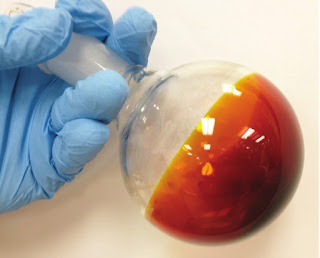 |
| The process of absorbing Mercury from water |
Dr Justin Chalker from the Flinders University utilized the industrial waste and orange peel to create absorbent formed in polymer. This polymer is called as Sulfur-Limonene Polysulfide or SLP which can permanently remove mercury either from soil or water. Surprisingly, the polymer that the team scientists used was able to change colour indicating the process of absorbing. This solution can solve the healthy issue in industries particularly in fossil fuel production and burning, gold mining and fungicides.
Interestingly, the Sulphur-Limonene Polysulfide was fabricated entirely from Sulphur, limonene which were obtained by petroleum industries and it has been produced for 70 million tonnes annually. Mercury is one the hazard heavy metals found commonly in water and soil. Mercury is symbolized as Hg and it the only metal which has liquid phase in standard conditions of temperature and pressure. Mercury is commonly functionalized as measure-meters such as thermometers, barometers, manometers and sphygmomanometers. But, the main problem of mercury is produced from combustion of coal-fired power plants.
Before experimenting with the mercury, the scientist performed palladium(II) removal process in water. Although Palladium is regarded as low toxic materials, the chemical compound may cause burns to skin and eyes. Unlike the Mercury which can cause damage in immune system, kidney and embryotoxic effects [2]. Sometimes also this heavy metal is considered as carcinogenic chemical element.
On the other hand, what is limonene? According to Wikipedia, Limonene is one of liquid hydrocarbon that is classified as cyclic terpene. This material is also considered as one the polymer which has stable condition so it can be oxidized easily and with sulfur it reacts with sulfur.
To conclude, the process of synthesizing the Sulphur-Limonene Polysulfide produces a high-qualified toxic metals absorbent. This unique absorbing property is treated to several metals including Lithium, lead, zinc and manganese. However, the most interesting thing is mercury because every metals that had been tested showing no-change colour except mercury.
References
[1] J. M. Chalker, M. P. Crockett, A. M. Evans, M. J. H. Worthington, I. S. Albuquerque, A. D. Slattery, C. T. Gibson, J. A. Campbell, D. A. Lewis and G. J. L. Bernardes, "Sulfur-Limonene Polysulfide: A material synthesized entirely from industrial by-products and its use in removing toxic metals from water and soil," Angewandte Chemie International Edition, no. 55, pp. 1714-1718, 2015.
[2] J. Wang, X. Feng, C. W. N. Anderson, Y. Xing and L. Shang, "US EPA Archive Document," 21 September 2007. [Online]. Available: https://archive.epa.gov/region5/teach/web/pdf/mercury_inorg_summary.pdf. [Accessed 15 August 2017].
[3] Image is credited to Chalker et al., 2015